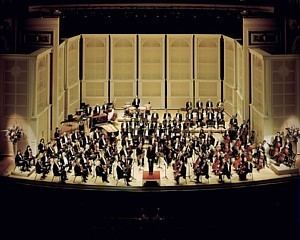 | ||
Similar Nikolai Sokoloff, Emil Paur, Artur Rodziński, Theodore Thomas, Cleveland Orchestra | ||
The Big Five orchestras of the United States are the five symphony orchestras that led the field in "musical excellence, calibre of musicianship, total contract weeks, weekly basic wages, recording guarantees, and paid vacations" when the term gained currency in the late 1950s and for some years afterwards. In order of foundation, they were:
Contents
Origins
The term "Big Five" was coined around the time that long-playing recordings became available, regular orchestral radio broadcasts were expanding, and the five orchestras that make up the group had annual concert series in New York City. In the early 20th century, people talked about the "Major Seven" U.S. orchestras. By mid-century, with recordings and radio broadcasts dominated by East Coast ensembles, it became the "Big Three": New York, Boston, and Philadelphia. While this label was still being used in the late 1950s (e.g. Newsweek, 17 February 1958), the growing prestige of the Cleveland Orchestra under George Szell and the Chicago Symphony Orchestra under Fritz Reiner at this time saw the "Big Three" become the "Big Five".
Modern use
People still refer to the "Big Five", but many believe the classification to be outdated. Several critics have suggested that the top echelon be expanded, including Michael Walsh in Time, 1983; Tim Page in Newsday, 1990; and Mark Swed in the Los Angeles Times, 2005. Among the orchestras proposed for inclusion are the Los Angeles Philharmonic, the San Francisco Symphony, the Atlanta Symphony Orchestra, the Pittsburgh Symphony Orchestra, the Houston Symphony, the Baltimore Symphony Orchestra, the National Symphony Orchestra (Washington, D.C.), the Minnesota Orchestra (Minneapolis), and the Saint Louis Symphony Orchestra.
Seven American orchestras were numbered among the world's top twenty in a 2008 critics' poll by Gramophone. They were, in rank order, the Chicago Symphony Orchestra (5th), the Cleveland Orchestra (7th), the Los Angeles Philharmonic (8th), the Boston Symphony Orchestra (11th), the New York Philharmonic (12th), the San Francisco Symphony (13th), and the Metropolitan Opera Orchestra (New York City) (18th).
In the 21st century, some observers of American orchestras suggest that the "Big Five" designation is no longer meaningful. Gary Hanson, executive director of the Cleveland Orchestra, commented in 2013 that an orchestra's reputation was once an important factor in its "ability to compete for talent", meaning that "there was a direct relationship between reputation and quality." Greater geographic mobility of musicians, the rarity of major orchestral recording contracts, and the existence of major year-round orchestras in more American cities have reduced the importance of the prestige that was once associated with the Big Five. A New York Times article suggested that "climate and cost of living are as likely to figure in a musician’s choice of employer as an orchestra’s historic renown." Additionally, the availability of a large number of talented young musicians is described as a "leveling factor" that enhances the quality of all American orchestras.
